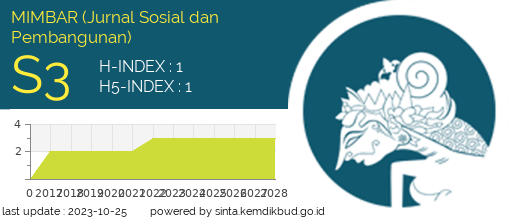Tourism Village Development Based on Participatory Planning
DOI:
https://doi.org/10.29313/mimbar.v39i2.2988Keywords:
Torusim, Village Development, ParticipatoryAbstract
The Bandung Regency Government plans to develop 100 tourist villages with the aim of accelerating the economic growth of the surrounding community. One of the potential tourist villages in Bandung Regency is Baros Village. Baros village has good potential to be developed, but there is no tourism planning for the village. In this study a participatory approach was used or in tourism it is better known as Community Based Tourism Development. The analysis used in this study is the 4A and SWOT analysis. From the results of the analysis carried out, it was found that the village of Baros has strengths in terms of various natural conditions and cultural values. The development of the tourism area is divided into 3 zones, namely the core zone, buffer zone and service zone.
References
Agustina, I. (2020). Socio-Cultural Heritage For Tourism At Cirebon Palaces Indonesia. MIMBAR : Jurnal Sosial Dan Pembangunan, 36(2), 511–519. https://doi.org/10.29313/mimbar.v36i2.6876
Aji, R., & Faniza, V. (2021). Land Cover Change Impact on Coastal Tourism Development near Pacitan Southern Ringroad. MIMBAR : Jurnal Sosial Dan Pembangunan, 37(1), 101–109. https://doi.org/10.29313/mimbar.v37i1.6620
Andari, N. Y. D. E. M. R. (2022). Strategi Pengembangan Desa Wisata Baros Kabupaten Bandung. Syntax Idea Impress, 4(2). https://jurnal.syntax-idea.co.id/index.php/syntax-idea/article/view/1764/1129
Bernini, C., Cerqua, A., & Pellegrini, G. (2020). Endogenous amenities, tourists’ happiness and competitiveness. Regional Studies, 54(9), 1214–1225. https://doi.org/10.1080/00343404.2020.1712350
Cochrane, L., & Corbett, J. (2020). Participatory Mapping. In J. Servaes (Ed.), Handbook of Communication for Development and Social Change (pp. 705–713). Springer Singapore. https://doi.org/10.1007/978-981-15-2014-3_6
Damayanti, V., Ekasari, A. M., & Syaodih, E. (2020). The Determinants of Cultural Tourism Attractions Based on Tourist Satisfaction in the Sundapolis Area, Bandung City. 409(SoRes 2019), 538–541. https://doi.org/10.2991/assehr.k.200225.117
Darcy, S., & Dickson, T. J. (2009). A Whole-of-Life Approach to Tourism: The Case for Accessible Tourism Experiences. Journal of Hospitality and Tourism Management, 16(1), 32–44. https://doi.org/https://doi.org/10.1375/jhtm.16.1.32
Fardani, I. (2018). Participatory Mapping Solution for Village Potential and Boundary. 194–208.
Fardani, I., Kurniasari, N., Syaodih, E., Rochman, G. P., & Pradifta, S. (2023). Pendampingan rencana tata ruang desa (rtrd) berbasis perencanaan partisipatif. Jurnal Pengabdian Kepada Masyarakat Membangun Negeri, 7(2), 72–84. http://www.jurnal-umbuton.ac.id/index.php/ppm/article/view/3472
Hossen, M. A. (2016). Participatory mapping for community empowerment. Asian Geographer, 33(2), 97–113.
Indratno, I., Rachmiatie, A., Martian, F., Yuniar, N., Sonya, V., & Anisa, Y. (2022). Development of Sustainable Halal Tourism in Alamendah Village, Bandung Regency. MIMBAR : Jurnal Sosial Dan Pembangunan, 0(0), 423–435. https://doi.org/10.29313/mimbar.v0i0.10860
Nuryanti, W. (1993). Concept, Perspective and Challenges, makalah bagian dari Laporan Konferensi Internasional mengenai Pariwisata Budaya (pp. 2–3). Gadjah Mada University Press.
Reihanian, A., Mahmood, N. Z. B., Kahrom, E., & Hin, T. W. (2012). Sustainable tourism development strategy by SWOT analysis: Boujagh National Park, Iran. Tourism Management Perspectives, 4, 223–228. https://doi.org/https://doi.org/10.1016/j.tmp.2012.08.005
Richards, G. (2002). Tourism attraction systems: Exploring Cultural Behavior. Annals of Tourism Research, 29(4), 1048–1064. https://doi.org/https://doi.org/10.1016/S0160-7383(02)00026-9
Salasa, M. Y. F., & Ismail, T. (2018). Analisis Pengaruh Attraction, Accessibility , Amenities, dan Ancillary Terhadap Kepuasan Wisatawan Pantai Tiga Warna Malang. Jurnal Ilmiah FEB, 7(1), 1–8.
Saud, M. I., Mentayani, I., Rahman, A., & Hadinata, I. Y. (2021). Arahan Penyusunan dan Perancangan Masterplan Desa Madu Retno Berbasis Wisata Budaya. 1(2), 134–145.
Yiu, C.-Y., & Cheung, K.-S. (2021). Urban Zoning for Sustainable Tourism: A Continuum of Accommodation to Enhance City Resilience. Sustainability, 13(13). https://doi.org/10.3390/su13137317
Zhang, X. (2012). Research on the Development Strategies of Rural Tourism in Suzhou Based on SWOT Analysis. Energy Procedia, 16, 1295–1299. https://doi.org/https://doi.org/10.1016/j.egypro.2012.01.207
Downloads
Published
Issue
Section
License
Copyright (c) 2023 MIMBAR : Jurnal Sosial dan Pembangunan

This work is licensed under a Creative Commons Attribution-NonCommercial-ShareAlike 4.0 International License.














